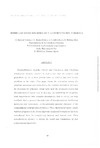Please use this identifier to cite or link to this item:
https://accedacris.ulpgc.es/jspui/handle/10553/57057
| DC Field | Value | Language |
|---|---|---|
| dc.contributor.author | Bolívar Toledo, Olga | en_US |
| dc.contributor.author | Muñoz Blanco, José Antonio | en_US |
| dc.contributor.author | Candela Solá, Santiago | en_US |
| dc.contributor.author | Moreno Díaz, Roberto | en_US |
| dc.date.accessioned | 2019-10-11T17:24:53Z | - |
| dc.date.available | 2019-10-11T17:24:53Z | - |
| dc.date.issued | 1991 | en_US |
| dc.identifier.issn | 1130-4723 | en_US |
| dc.identifier.other | Dialnet | |
| dc.identifier.uri | https://accedacris.ulpgc.es/handle/10553/57057 | - |
| dc.description.abstract | Neurocybernetic, Systems Theory and Perception, and Artificial lntelligence Systems, interact in such a way that the methods and procedures of one of them provide clues in order to face and resolve problems in the others. This paper shows the interaction among the algebraic-analytical data fields theory, the complete descriptions that may be truncated for practical visual tasks and the structural-functional characteristics of neural nets. In this way, on researching the properties and requirements that complete descriptions had to verify, we may conclude that a general characteristic of transformations combining partitions and functionals, is the esentially parallel character of the computational structure that performs it. Then, the temporal factor, which had been forgotten in the former algebraic-analytical formulation has been introduced here, by considering layered and neural nets. This consideration allows's to clarify the reach and limitations of fast computational algorithms. | en_US |
| dc.language | eng | en_US |
| dc.relation.ispartof | Revista de la Academia Canaria de Ciencias | en_US |
| dc.source | Revista de la Academia Canaria de Ciencias = Folia Canariensis Academiae Scientiarum [ISSN 1130-4723], v. 3 (2), p. 95-103 | en_US |
| dc.subject | 120304 Inteligencia artificial | en_US |
| dc.subject.other | Visión artificial | en_US |
| dc.subject.other | Artificial vision | en_US |
| dc.title | Sobre las redes neuronales y la computación paralela | en_US |
| dc.type | info:eu-repo/semantics/article | en_US |
| dc.type | Article | en_US |
| dc.identifier.url | http://dialnet.unirioja.es/servlet/articulo?codigo=2905201 | - |
| dc.description.lastpage | 103 | - |
| dc.identifier.issue | 2 | - |
| dc.description.firstpage | 95 | - |
| dc.relation.volume | 3 | - |
| dc.investigacion | Ingeniería y Arquitectura | en_US |
| dc.type2 | Artículo | en_US |
| dc.contributor.authordialnetid | 574958 | - |
| dc.contributor.authordialnetid | 2421194 | - |
| dc.contributor.authordialnetid | 1213701 | - |
| dc.contributor.authordialnetid | 1213705 | - |
| dc.identifier.dialnet | 2905201ARTREV | - |
| dc.identifier.ulpgc | Sí | es |
| item.fulltext | Con texto completo | - |
| item.grantfulltext | open | - |
| crisitem.author.dept | GIR IUCES: Computación inteligente, percepción y big data | - |
| crisitem.author.dept | IU de Cibernética, Empresa y Sociedad (IUCES) | - |
| crisitem.author.dept | Departamento de Informática y Sistemas | - |
| crisitem.author.dept | GIR IUCES: Computación inteligente, percepción y big data | - |
| crisitem.author.dept | IU de Cibernética, Empresa y Sociedad (IUCES) | - |
| crisitem.author.orcid | 0009-0008-9619-7341 | - |
| crisitem.author.parentorg | IU de Cibernética, Empresa y Sociedad (IUCES) | - |
| crisitem.author.parentorg | IU de Cibernética, Empresa y Sociedad (IUCES) | - |
| crisitem.author.fullName | Muñoz Blanco, José Antonio | - |
| crisitem.author.fullName | Moreno Díaz,Roberto | - |
| Appears in Collections: | Artículos | |
Page view(s)
195
checked on May 31, 2025
Download(s)
249
checked on May 31, 2025
Google ScholarTM
Check
Share
Export metadata
Items in accedaCRIS are protected by copyright, with all rights reserved, unless otherwise indicated.
